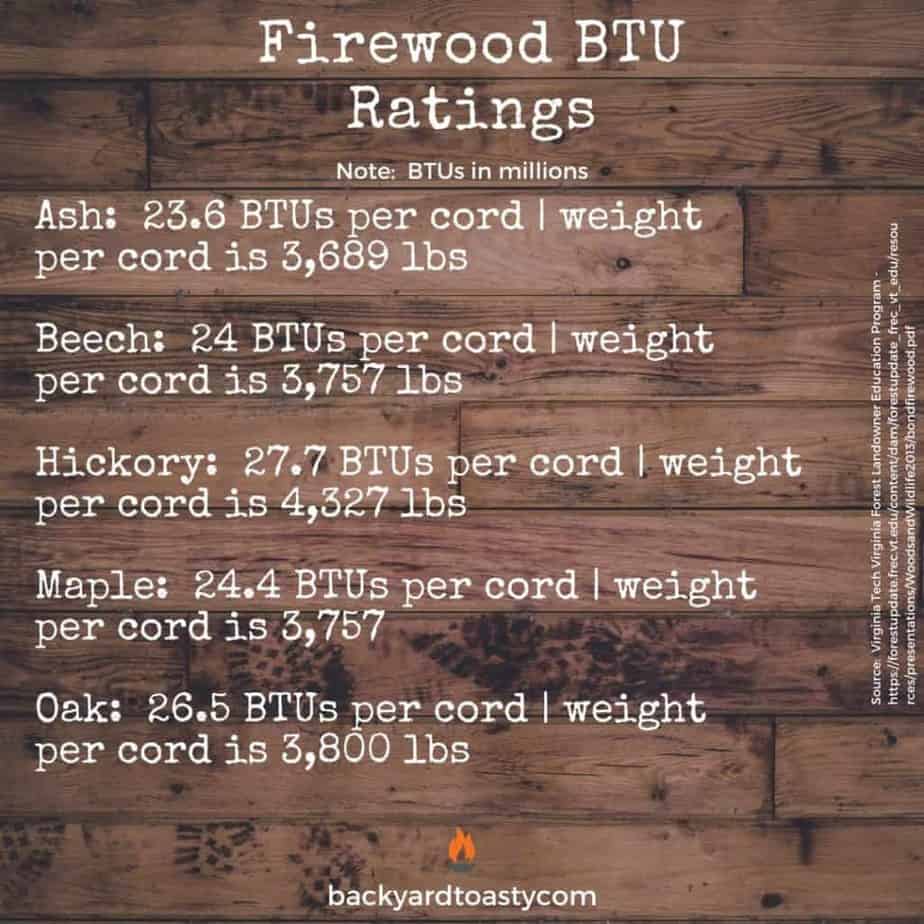When building a fire in your fire pit, you want quick lighting, hot burning, long-lasting firewood, right? Having the best burning fire pit firewood will help you get there every time.
That doesn’t always happen though because sometimes we use wood for our fire pits that we have easy access to, even if it’s not a great option.
I know this and still, on occasion, use certain woods as firewood from trees I’ve cut up on my property, taken down by storms, or other reasons.
If you’ve done some clearing and grubbing on your property, and you’ve split and stacked some wood, you’ll most likely tap that source like I have, whether it’s good, well-seasoned wood or not.
With that said though, the type and degree of seasoning with regard to burning can make all the difference in the world from a performance standpoint.
If you are serious about your fire pit, you’ll need to know what the best burning firewood types are and what it takes to get them ready to burn.
Generally, the following are among the best burning hardwood firewoods for fire pit use, based on heat output, burn time, seasoning time, and availability:
Ash: Commonly at the top of lists of best firewoods, ash is quick seasoning, burns very hot and is easy to work with if you are prepping your own wood for fire pit use. White ash, specifically, is a common option for firewood.
Beech: Very similar to ash in heat performance and longevity of burn. A little slow to season due to the high moisture content in the wood. Also, beech can be difficult to split and challenging to light at times.
Hickory: Among the hottest burning of hardwoods, hickory is easy to find, seasons quickly, smells great when burning, and burns long. Shagbark and Bitternut hickory are common options for firewood.
Maple: Hard maples, like sugar maple, are easy to find and burn long and hot in a fire pit.
Oak: This extremely dense hardwood has high availability and burns hot and long, but can be challenging to light. White oak is a common option for fire pit firewood.
Most of these firewood options are generally available throughout North America and mainland Europe, as well as in the U.K. and Ireland.
A smaller combination of these firewood types can be found throughout South America, Asia, Australia, and North Africa.

What is Hardwood?
Hardwoods, in a “best burning firewood” context, are generally are heavier and denser and thus tend to burn hotter and longer, making them a desirable option for many over softwoods (ex. pines, birch, cedar, etc.) as the main fuel source in a fire pit.
There are some exceptions to this on the softwood side, like firewood from yew trees, but generally, pound for pound, hardwoods are a better choice.
Also, softwoods tend to have a higher moisture content, so seasoning often takes much longer.
For those looking for a more technical answer, the American Hardwood Information Center defines hardwoods as,
…deciduous trees that have broad leaves, produce a fruit or nut, and generally go dormant in the winter. North America’s forests grow hundreds of varieties that thrive in temperate climates, including oak, ash, cherry, maple, and poplar species. Each species can be crafted into durable, long-lasting furniture, cabinetry, flooring, and millwork, and each offers unique markings with variation in grain pattern, texture, and color.
– American Hardwood Information Center
How Is Firewood Heat Output Measured and Why Should I Care?
A common metric for the heat output of a particular type of firewood is the British Thermal Unit or BTU. A BTU is essentially the measure of heat necessary to heat one pound of water 1 degree Fahrenheit.
For the purposes of obtaining the best burning firewood for your fire pit, the higher the BTU number, the higher the amount of energy present for burning in each unit of wood you possess.
A typical way to represent this amount of energy in firewood is the BTU value per cord of wood. A cord of wood is a well-stacked pile of firewood measuring 4 feet high, 8 feet wide, and 4 feet deep (see firewood BTU chart below).

Knowing this information will help you select a wood for firewood that gives you a better value for your chopping, stacking, and seasoning effort, or your hard-earned dollars if you choose to go with a local supplier.
What is Seasoned Firewood?
Seasoned firewood is essentially firewood that has been split, stacked, and allowed to dry for a set period of time.
Naturally, each type of wood contains a certain amount of moisture that is particular to each. If not properly seasoned, firewood will not burn as effectively as its capable of when dried properly.
Each type of wood used for firewood has its own level of moisture content, usually measured as a percentage of the wood’s mass. A wood’s moisture content (%) and density are primary determiners of proper seasoning time.
As I said before, hardwoods typically have a lower moisture content and higher density, thus their seasoning time is shorter than choices on the softwood side.
In an effort to provide solid best burning firewood recommendations for your fire pit use, the hardwood options we’ve talked about so far, ash, beech, hickory, maple, and oak, all have generally short seasoning times of around 6-12 months, based on moisture content and density.

alternative that burns hot and long…if you can find it
Some Great “Best Burning Fire Pit Firewood” Alternatives
If you have any trouble finding any of the options mentioned (you probably won’t) or are looking for some alternatives, the following will firewood choices will not let you down.
Black locust, a heavy, very dense wood, is a solid alternative firewood choice as it burns very hot (29.3 BTUs per 4,200 lb cord) and seasons in about a year.
However, black locust is very localized in the southeastern part of the U.S. with a few exceptions, so it may not be available in your area. I left it off the original list above for this reason.
Another decent alternative firewood option is apple. Apple is extremely dense, burns hot (26.5 BTUs per 4,140 lb cord) with a smaller flame, and smells great when used in a fire pit. Like black locust, availability can be a limiting factor.
Conclusion: Best Burning Firewood
The list of best burning firewood I recommended in this post is certainly not all-inclusive, as there is a huge variety of wood choices available for fire pit use.
My goal for this post was to narrow that variety of choices down to a small list of five firewood options that met a very specific set of criteria; hardwoods with high heat output, burn time, relatively short seasoning time, and general availability.
Each one of these choices, ash, beech, hickory, maple and oak, all meet my “best burning firewood” criteria. While they all share these criteria in common, they are all unique in their own right and if you are able, experiment with each of them to find your preference.
For more on the subject of making sure you have great performing firewood, check out my article How to Stack Firewood for Your Fire Pit.
Thanks for reading!
John

